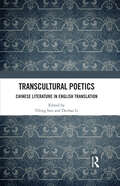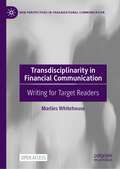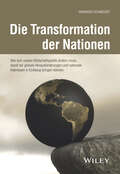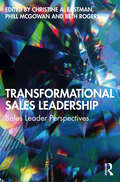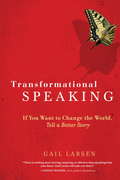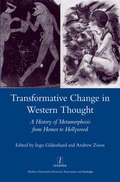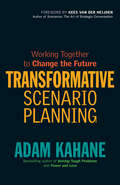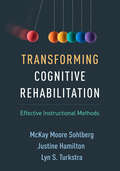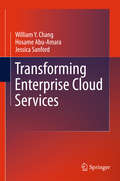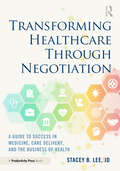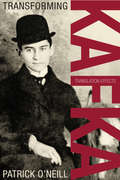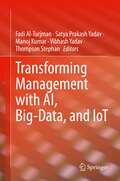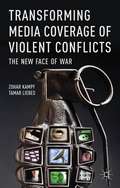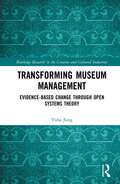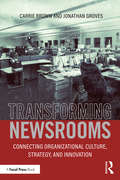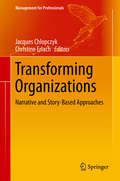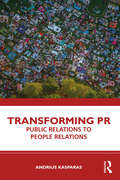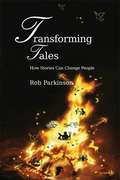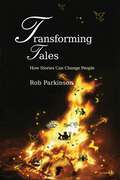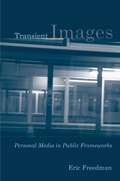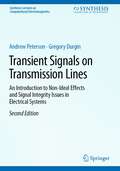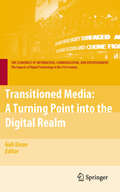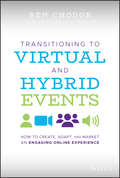- Table View
- List View
Transcultural Poetics: Chinese Literature in English Translation
by Yifeng Sun Dechao LiThis book examines many facets of transcultural poetics in the English translation of Chinese literature from 12 different expert contributors.Translating Chinese literature into English is a special challenge. There is a pressing need to overcome a slew of obstacles to the understanding and appreciation of Chinese literary works by readers in the English-speaking world. Hitherto only intermittent attempts have been made to theorize and explore the exact role of the translator as a cultural and aesthetic mediator informed by cross-cultural knowledge, awareness, and sensitivity. Given the complexity of literary translation, sophisticated poetics of translation in terms of literary value and aesthetic taste needs to be developed and elaborated more fully from a cross-cultural perspective. It is, therefore, necessary to examine attempts to reconcile the desire for authentic transmission of Chinese culture with the need for cultural mediation and appropriation in terms of the production and reception of texts, subject to the multiplicity of constraints, in order to shed new light on the longstanding conundrum of Chinese-English literary translation by addressing Chinese literature in the multiple contexts of nationalism, cross-cultural hybridity, literary untranslatability, the reception of translation, and also world literature. The book will be of great interest to students and scholars of translation studies, Chinese literature, and East Asian studies.
Transdisciplinarity in Financial Communication: Writing for Target Readers (New Perspectives in Organizational Communication)
by Marlies WhitehouseThis open access book identifies and analyses problems of text production in finance from three complementary perspectives: problem identification, problem analysis, and problem solution. By doing so, it explains why solving these problems in transdisciplinary collaboration benefits theory, practice, and society at large. Drawing on 25 years of ethnographic research, roughly 2100 text products, and more than 190 interviews with different stakeholders, it develops and evaluates measures to improve the communicative potential of financial texts and thereby make them accessible to professionals. The book will appeal to researchers and reflective practitioners in financial communication, organizational communication, financial analysis, investor relations, journalism, and applied linguistics.
Transformation der Nationen (AT)
by Reinhard SchneiderJahrzehntelang waren die technologisch fortgeschrittenen Länder des Westens die Nutznießer der Globalisierung auf Basis der von ihnen geschaffenen Wirtschaftsordnung. Jetzt ändern sich die geopolitischen und wirtschaftlichen Verhältnisse mit Wucht. Gleichzeitig hat sich in den letzten Jahren die Erkenntnis durchgesetzt, dass wir unsere Wirtschaft auf CO2-freies Wirtschaften umstellen müssen. Zudem altern viele Gesellschaften. Deutschland und Europa tun sich sichtlich dabei schwer, ihre Nationen zukunftsfähig zu gestalten. Gerade bei der passenden Wirtschaftspolitik hakt es. Reinhard Schneiders These ist: Es braucht in Deutschland und Europa dringend einen politischen, wirtschaftlichen und gesellschaftlichen Wandel. Diesen schaffen wir aber nur, wenn wir die Grundlagen unseres Wohlstands verstehen. Leider ist das Verständnis der wirtschaftlichen Zusammenhänge in der Politik und der breiten Bevölkerung oft lückenhaft und es kommt zu Fehleinschätzungen. Dies beginnt schon bei der mangelnden Unterscheidung zwischen Tätigkeiten, die Kosten für eine Gesellschaft auslösen, und Tätigkeiten, die Einkommen für eine Gesellschaft generieren. Eine wesentliche Ursache ist die Art, wie wir Wertschöpfung und Einkommen von Nationen bzw. Staaten wie Deutschland definieren und messen. Fest steht: Wenn Nationen ihren Wohlstand halten wollen, müssen sie konkurrenzfähig sein. Attraktive und konkurrenzfähige Produkte werden mittlerweile überall angeboten; bei Amazon ist man nur einen Klick vom weltweiten Angebot entfernt. Während die USA und China verstehen, dass sie ihr Einkommen steigern müssen, wenn sie mehr Wohlstand haben wollen, rümpfen die Europäer die Nase über den Neoliberalismus. Sie rufen lieber nach Geld vom Staat oder der EU zur Steigerung der Nachfrage. Auf diesem Weg werden Deutschland und Europa Gefahr laufen, abgehängt zu werden. Das Buch liefert eine längst überfällige Darstellung der Realität der Wirtschaft. Es soll helfen, richtige Entscheidungen zu treffen. Nur so gelingt uns, vor dem Hintergrund der aktuellen globalen Herausforderungen, der Wandel in eine erfolgreiche Zukunft - die Transformation der Nationen.
Transformational Sales Leadership: Sales Leader Perspectives
by Beth Rogers Christine A. Eastman Phill McGowanTransformational Sales Leadership: Sales Leader Perspectives offers viewpoints from 12 leaders across the global sales industry, all of which challenge conventional sales models and promote visionary ways of thinking about sales and leadership.The leaders who share their professional stories in the book are from organizations including SAP, Google, Nationwide US, and Royal Caribbean, as well as their own practices, and they represent a new breed of salespeople who are increasingly sought after by organizations which need to transform their practices. They run teams, drive analytics, and improve operational excellence, and their careers rise or fall on getting the right KPIs. Their stories address solutions to age-old sales problems, but they bring a new perspective to the sales function in the digital age. The book focuses on what sales leaders need in order to be innovative. Specifically, the book shows you how to:• Coach sales people through disruption;• Leverage the most valuable habits for success; and• Provide for meaning and purpose in the hyper-connected and volatile sales industry.If you are a sales professional looking to succeed in challenging scenarios, the journeys recounted in this book demonstrate how the landscape of sales has changed and how thinking about sales differently can help you transform your career.
Transformational Speaking: If You Want to Change the World, Tell a Better Story
by Gail LarsenYou can change the world--one audience at a time! Today's challenging times call for passionate visionaries who are authentic and articulate communicators. Speaking coach and consultant Gail Larsen presents a proven program that liberates the "speaker within" and transforms even the reluctant orator into an agent of change. While most books on public speaking focus on polishing your presentation and overcoming fear, Larsen's holistic blend of spirit and logic goes far beyond the standard format, making TRANSFORMATIONAL SPEAKING a must-read for even the most seasoned speechmakers. With her uniquely inspirational approach, Larsen reaches out to those who want to make a genuine difference in our world by changing minds through touching hearts. TRANSFORMATIONAL SPEAKING offers insightful advice on everything from defining your message and refining your delivery, to managing the dynamics of a room, handling logistics like a pro, and building a connection with an audience of any size. Larsen has helped business executives and entrepreneurs, community and social change leaders, and healers and life coaches become active movers and shakers through the power of effective communication.
Transformative Change in Western Thought: A History of Metamorphosis from Homer to Hollywood
by Ingo GildenhardThis groundbreaking volume maps the shifting place and function of marvelous transformations from antiquity to the present day. Shape-shifting, taking animal bodies, miracles, transubstantiation, alchemy, and mutation recur and echo throughout ancient and modern writing and thinking and continue in science fiction today as tales of gene-splicing and hybridisation. The idea of metamorphosis lies in uneasy coexistence with orderly world views and it is often cast out, or attributed to enemies. Augustine and the church fathers consider shape-shifting ungodly; Enlightenment thinkers suppress alchemy as unscientific; genetically-modified wheat and stem-cell research are stigmatised as unnatural. Yet the very possibility of radical transformation inspires hope just as it frightens. A provocative, theorising, trans-historical history, this book ranges across classics, literature, history, philosophy, theology and anthropology. From Homer and Ovid to Proust and H. P. Lovecraft and through figures from Proteus to Kafka's Fly and toSpiderman, four historical surveys are combined with nine case studies to show the malleable, yet persistent, presence of transformation throughout Western cultural history.
Transformative Negotiation: Strategies for Everyday Change and Equitable Futures
by Sarah FedermanA contemporary guide to negotiation that centers an understanding of power Transformative Negotiation advances an understanding of power and oppression as core to negotiation, arguing that negotiation is central to social mobility and social change. Bringing theory into action, the book explores the real-world examples that Sarah Federman’s own students bring to class, such as negotiating with courts to get their kids back or with the IRS to reduce late fees. Federman explains how heritage, ethnicity, wealth, gender, age, education, and other factors influence what we ask for and how people respond to our requests, as well as what is at stake when we negotiate. This book provides tools to help readers gain confidence in their everyday negotiation skills and link personal success to social transformation.
Transformative Scenario Planning: Working Together to Change the Future
by Adam Kahane&“Take[s] scenario planning to a new level, beyond the confines of business strategy, to deal with wider social and economic issues.&”—Vince Cable, former Secretary of State for Business, UK People who are trying to solve tough economic, social, and environmental problems often find themselves frustratingly stuck. They can&’t solve their problems in their current context, which is too unstable or unfair or unsustainable. They can&’t transform this context on their own—it&’s too complex to be grasped or shifted by any one person or organization or sector. And the people whose cooperation they need don&’t understand, agree with, or trust them…or each other. Transformative scenario planning is a powerful new methodology for dealing with these challenges. It enables us to transform ourselves and our relationships and thereby the systems of which we are a part. At a time when divisions within and among societies are causing so many people to get stuck and to suffer, it offers hope—and a proven approach—for moving forward together. Praise for Adam Kahane&’s books &“Thought-provoking discourse on handling difficult situations.&”—Publishers Weekly &“Profound . . . a wise way to negotiate our toughest group, community, and societal challenges.&”—William Ury, New York Times–bestselling coauthor of Getting to Yes
Transforming Cognitive Rehabilitation: Effective Instructional Methods
by McKay Moore Sohlberg Justine Hamilton Lyn S. TurkstraGrounded in cutting-edge knowledge about cognitive function and recovery from brain injury, this practical reference and text builds on the authors' influential earlier work, Optimizing Cognitive Rehabilitation. It incorporates major advances in the field to provide a new framework for assessing patients and developing individualized rehabilitation plans. The distinguished authors present principles and procedures for promoting engagement, teaching cognitive strategies and discrete facts and routines, introducing external cognitive aids, and supporting patients' social competence. Additional topics include considerations for using computer-based training, managing functional cognitive symptoms, and providing cognitive rehabilitation in the inpatient setting. The book features detailed case illustrations and filled-out examples of 19 reproducible planning and progress monitoring forms. Blank forms can be downloaded and printed in a convenient 8 1/2" x 11" size.
Transforming Communication in Leadership and Teamwork
by Renate Motschnig David RybackThis accessible, highly interactive book presents a transformative approach to communication in leadership to meet workplace challenges at both local and global levels. Informed by neuroscience, psychology, as well as leadership science, it explains how integrating and properly balancing two key focal points of management--the tasks at hand and the concerns of others and self--can facilitate decision-making, partnering with diverse colleagues, and handling of crises and conflicts. Case examples, a self-test, friendly calls for reflection, and practical exercises provide readers with varied opportunities to assess, support, and evoke their readiness to apply these real-world concepts to their own style and preferences. Together, these chapters demonstrate the best outcomes of collaborative communication: greater effectiveness, deeper empathy with improved emotional fulfillment, and lasting positive change. Included in the coverage: #65533; As a manager, can I be human? Using the two-agenda approach for more effective--and humane--management. #65533; Being and becoming a person-centered leader and manager in a crisis environment. #65533; Methods for transforming communication: dialogue. #65533; Open Case: A new setting for problem-solving in teams. #65533; Integrating the two agendas in agile management. #65533; Tasks and people: what neuroscience reveals about managing both more effectively. #65533; Transforming communication in multicultural contexts for better understanding across cultures. As a skill-building resource, Transforming Communication in Leadership and Teamwork offers particular value: #65533; to diverse business professionals, including managers, leaders, and team members seeking to become more effective#65533; business consultants and coaches working with people in executive positions and/or teams#65533; leaders and members of multi-national teams #65533; executives, decision makers and organizational developers #65533; instructors and students of courses on effective communication, social and professional skills, human resources, communication and digital media, leadership, teamwork, and related subjects.
Transforming Enterprise Cloud Services
by Jessica Feng Sanford Hosame Abu-Amara William Y ChangTransforming Enterprise Cloud Services addresses the fundamental ideology of Cloud Services and how enterprises in commercial, federal, and defense industries can transform their current information technology and management models to adopt this new method. It goes beyond the mere description of service frameworks in relation to cloud technologies and operations and provides practical path-forward solutions for identified challenges. For instance, as organizations transform their data and service models to compete in a new environment where data and services coexist with others in a public-held eco-system, enterprises have to face the challenge of data synthesis from a massive number of sources. One answer to this issue relies on a cross-organizational policy and technology coordination that can ensure that data will not be reproduced or manipulated by unauthorized entities. Transforming Enterprise Cloud Services explains how organizations can justify their current practices to take advantage of such collaboration synthesis securely, safely, reliably, and cost-effectively. Transforming Enterprise Cloud Services elucidates the service-oriented nature of Cloud Services and identifies issues and challenges from clients' and vendors' perspectives. It also portrays how enterprise operators can successfully deploy their IT environment from both business and technical perspectives to enable massive scalability, high resilience, enforced security, and collaborative dynamics.
Transforming Healthcare Through Negotiation: A Guide to Success in Medicine, Care Delivery, and the Business of Health
by Stacey B. LeeEvery day, healthcare professionals face high-stakes negotiations that directly impact patient outcomes, organizational success, and career advancement. Transforming Healthcare Through Negotiation introduces the HEAR Approach™—a proven system developed specifically for healthcare's unique challenges across clinical care, service delivery, and business operations.This practical guide equips physicians, administrators, and healthcare leaders with immediately applicable strategies to transform potential conflicts into collaborative solutions that advance patient care while balancing competing priorities.Inside, discover: A Relational Mindset that builds trust across professional boundaries Field-tested negotiation strategies tailored to healthcare’s distinct environments Tactical approaches for maintaining momentum in time-sensitive situations Ready-to-use tools, including the Negotiation Planner and Trilingual Planner "Transforming Healthcare Through Negotiation is an essential read for healthcare leaders... Stacey Lee’s HEAR Approach™ masterfully provides a structured, relational approach that balances clinical, operational, and financial priorities."— Regina Herzlinger, PhD; Brian Walker, DrPH; Ben Creo, MDiv, Harvard Business School"The HEAR Approach™ has improved healthcare and will make you better... aligned beautifully with principles of optimal clinical practice."— James K. Stoller, MD, MS, Chair of the Education Institute, Cleveland Clinic
Transforming Kafka
by Patrick O'NeillLyrical, mysterious, and laden with symbolism, Franz Kafka's novels and stories have been translated into more than forty languages ranging from Icelandic to Japanese. In Transforming Kafka, Patrick O'Neill approaches these texts through the method he pioneered in Polyglot Joyce and Impossible Joyce, considering the many translations of each work as a single, multilingual "macrotext."Examining three novels - The Trial, The Castle, and America - and two short stories - "The Judgment" and "The Metamorphosis" - O'Neill offers comparative readings that consider both intertextual and intratextual themes. His innovative approach shows how comparing translations extends and expands the potential meanings of the text and reveals the subtle differences among the hundreds of translations of Kafka's work. A sophisticated analysis of the ways in which translation shapes, rearranges, and expands our understanding of literary works, Transforming Kafka is a unique approach to reading the works of a literary giant.
Transforming Management with AI, Big-Data, and IoT
by Manoj Kumar Fadi Al-Turjman Satya Prakash Yadav Thompson Stephan Vibhash YadavThis book discusses the effect that artificial intelligence (AI) and Internet of Things (IoT) have on industry. The authors start by showing how the application of these technologies has already stretched across domains such as law, political science, policy, and economics and how it will soon permeate areas of autonomous transportation, education, and space exploration, only to name a few. The authors then discuss applications in a variety of industries. Throughout the volume, the authors provide detailed, well-illustrated treatments of each topic with abundant examples and exercises. This book provides relevant theoretical frameworks and the latest empirical research findings in various applications. The book is written for professionals who want to improve their understanding of the strategic role of trust at different levels of the information and knowledge society, that is, trust at the level of the global economy, of networks and organizations, of teams and work groups, of information systems and, finally, trust at the level of individuals as actors in the networked environments.Presents research in various industries and how artificial intelligence and Internet of Things is changing the landscape of business and management;Includes new and innovative features in artificial intelligence and IoT that can help in raising economic efficiency at both micro and macro levels;Examines case studies with tried and tested approaches to resolution of typical problems in each application of study.
Transforming Media Coverage of Violent Conflicts
by Zohar Kampf Tamar LiebesWhat links the interviews with Saddam Hussein and Mahmoud Ahmadinejad on British and American TV, the chase of journalists following mega-terrorists, and the new status conferred on ordinary people at war? Transforming Media Coverage of Violent Conflicts offers a timely and original discussion on the shift in war journalism in recent years.
Transforming Museum Management: Evidence-Based Change through Open Systems Theory (Routledge Research in the Creative and Cultural Industries)
by Yuha JungMuseums must change to illuminate the histories, cultures, and social issues that matter to their local population. Based on a unique longitudinal ethnographic study, Transforming Museum Management illustrates how a traditional art museum attempted to transform into a more inclusive and community-based institution. Using open systems theory and the Buddhist concept of mutual causality, it examines the museum’s internal management structure and culture, programs and exhibitions, and mental models of museum workers. In providing both theoretical and practical foundations to transform management structures, this accessible volume will benefit stakeholders by proposing a new culture and structure to arts institutions, to change practice to be more relevant, diverse, and inclusive. This book will be an invaluable resource for researchers and advanced students of museum studies, cultural management, arts administration, non-profit management, and organizational studies.
Transforming Newsrooms: Connecting Organizational Culture, Strategy, and Innovation
by Carrie Brown Jonathan GrovesTransforming Newsrooms offers a practical guide to navigating structural and culture change for news organizations facing economic disruption in today’s rapidly changing media landscape. Even when the need for change is obvious, the best ideas and intentions are often not followed by successful execution. This book offers a road map for understanding the obstacles to change in news organizations and how to overcome them. Providing a detailed overview of the ways in which news processes and routines are being fundamentally altered to meet new demands for multimedia, interactivity, and immediacy, the book offers tips to help news organizations better serve communities by understanding what information people need and how they want to engage and collaborate. The book also features a variety of case studies and examples from news organizations of all kinds, including a 10-year in-depth investigation of the Christian Science Monitor, the first national news organization to stop its daily presses for a digital report. Transforming Newsrooms is an invaluable resource for students and media professionals alike, demonstrating how to make research on organizational change actionable and help build a more equitable journalism model that will survive and thrive when we need it most.
Transforming Organizations: Narrative and Story-Based Approaches (Management for Professionals)
by Jacques Chlopczyk Christine ErlachAchieving true change and innovation depends on our ability to re-imagine and re-author the futures we want our organizations to have – and to open new perspectives and new ways of thinking, being and doing in the process. Narrative approaches and storytelling are powerful tools that can help us create a new future for branding and marketing, change, leadership, organizational learning and development. Gathering contributions by scholars and practitioners from various disciplines, this book provides a unique overview of an emerging field of practice in organizations and communities. Rooted in a narrative conceptual framework, the respective papers describe a broad range of trans-disciplinary applications, tools and methods for effectively working with stories.
Transforming PR: Public Relations to People Relations
by Andrius KasparasThis book introduces the concept of the Picnic Society – a society which we all belong to today because social media has given us unlimited opportunities to create or destroy our own and our circle’s (our bubble’s) realities, possibilities, and reputations.In today’s world every organization is integrated into society, and the people belonging to organizations are integrated into various continually interacting communities. Social media has – or soon will – erase any remaining boundaries between organizations and the world’s social fabric. It is increasingly pointless for organizations to try to establish relationships with society, because these already exist – 24 hours per day, 7 days per week, and all 365 days of the year. This is what I mean in talking about the transformation of the field of PR – from Public Relations to People Relations. This book discusses the challenges facing public relations professionals working in a contemporary society that is flooded with information, offers endless channels of communication, gives rise to true and false leaders, and is marked by both openness and mistrust, by real and fake news.This book will appeal to professionals who already have a solid grasp of public relations technologies but would like to review their skills and develop their own model of public relations know-how without being limited by the strict boundaries of traditional PR theory.
Transforming Tales: How Stories Can Change People
by Rob ParkinsonWritten by an experienced professional storyteller, this book contains about 90 short stories, from traditional fables and myths to modern yarns and jokes, allowing readers to understand the hidden patterns storytellers use to captivate attention and reveal truths. The author delves into the therapeutic value of stories and how they can instigate real change in people's lives, and shows how to create original stories and short metaphors. The book's readership includes those working to facilitate psychological and personal change, including therapists, social workers, coaches, teachers, managers, and presenters, as well as storytellers.
Transforming Tales: How Stories Can Change People
by Rob Parkinson'A very interesting and unusual book...The central theme of stories for change is challenging and exciting and it offers a good deal of wisdom about working with stories and insights into the stories themselves' â?? Mary Medlicott, storyteller, author of Shemi's Tall Tales and Cooking up a Story 'An illuminating account of the stories behind, within, above and below metaphors. The author's style is wonderfully engaging and flows beautifully from start to finish... This book will inspire anyone who works in therapeutic, creative, educational or business settings as well as being a joyful read to those who are fascinated by stories, fables and folklore. - Jaycee la Bouche, hypnotherapist, NLP confidence coach and children's relaxation teacher, Relax Kids ''This is a source of fabulous ideas and insights on the art of storytelling I will dip into again and again. Thought provoking explanations and rich examples are underpinned with biological information all of which flow easily from Rob's huge experience and skill as a storyteller. It seems as if stories really are wound into our DNA.' â?? Andy Vass, psychotherapist, coach and author of Teaching with Influence and Coaching and Mentoring for Leaders The power of story in our lives is far from adequately understood in contemporary culture. Equally the therapeutic power of storytelling, how it can quite literally entrance and even heal, has been ignored until recently. Transforming Tales reveals the true of impact of stories on our lives and how stories can create feelings of hope, take away psychological distress and even stimulate the immune system. Written by an experienced professional storyteller, this book contains over 90 short stories, from traditional fables to fascinating modern yarns, and allows readers to understand the hidden patterns storytellers use to captivate attention and learn how truths are often encapsulated in myths, jokes and fairy stories.The author focuses on the therapeutic value of stories and how they can instigate real change in people's lives. The book also reveals everything you need to know to create vibrant, memorable, original stories and short metaphors for yourself. This extraordinary journey into imagination and understanding will be an illuminating read for those professionally concerned with psychological and personal change and anyone who wants to learn more about the power and significance of stories.
Transient Images: Personal Media in Public Frameworks
by Eric FreedmanIn this probing study, Eric Freedman focuses on what images from photography, mobile communications, and the Internet reveal about looking. Exploring subjectivity by critically examining the look, he elaborates on the nature of the photographic frame and its relation to interpretive practices. Freedman scrutinizes what he calls "technobiography"—a life written through technology, and considers the movement of personal images into public spaces. He also considers authorship that situates the self as inherently engaged with and inscribed by information technology. All of the chapters in Transient Images explore Freedman's interest in examining how media technologies activate particular notions of self and community. He provides examples that address trauma—pictures of missing children on milk cartons and episodes of the reality series Intervention—as well as the strategies behind creating and distributing personal advertisements on the Internet. Transient Images draws out the tensions that exist in images circulating in the digital era.
Transient Signals on Transmission Lines: An Introduction to Non-Ideal Effects and Signal Integrity Issues in Electrical Systems (Synthesis Lectures on Computational Electromagnetics)
by Andrew Peterson Gregory DurginThis book provides an introduction to transmission line effects in the time domain. Fundamentals including time of flight, impedance discontinuities, proper termination schemes, nonlinear and reactive loads, and crosstalk are considered. Required prerequisite knowledge is limited to conventional circuit theory. The material is tutorial for electrical and computer engineers on the topic of transient signals on transmission lines. Emphasis has been placed on aspects of the subject that have application to signal integrity and high-speed digital circuit design issues, including proper termination schemes to avoid impedance discontinuities, reactive and nonlinear loads, and an introduction to crosstalk.The coverage focuses on the very important topic of transmission line transients which have been de-emphasized in most current textbooks. This book is prepared to supplement traditional texts for advanced students studying electromagnetics and for a vast array of practicing electrical engineers, computer engineers and material scientists with interests in signal integrity and high-speed digital design.In this second edition, examples and new problems have been added throughout. A new chapter on differential transmission lines has also been incorporated
Transitioned Media
by Gali EinavThe media industry is in transition. While some changes are readily apparent, we have not even begun to understand the impact of others. The result is one of the most fascinating times in the history of media. As digital technologies accelerate the pace of change in all facets of our lives, researchers and practitioners are exploring its impact on traditional media and social interaction. Transitioned Media brings together leading academics and media industry executives to identify and analyze the most transformative trends and issues. Themes include the effect of digital technologies on consumer behavior, new approaches to advertising and branding, social networks, the blogosphere and impact of "citizen" journalism, music and intellectual property rights, digital cinema, and video games. Underlying the chapters is an economic perspective, with an emphasis on how new business models are being developed that take the social dimensions of digital technologies into account. The result is a unique perspective on the digital media landscape and the forces that will shape it in the future.
Transitioning to Virtual and Hybrid Events: How to Create, Adapt, and Market an Engaging Online Experience
by Ben ChodorCreating virtual events is not as simple as moving the same content online — learn how to immediately leverage virtual solutions for effective in-person online events As the global COVID-19 pandemic continues to have unprecedented impact on both the global economy and the whole of the world population, the need for effectively and efficiently connecting people and the right information has never been more urgent. Although the technology infrastructure currently exists, many organizations are scrambling to create virtual meetings and events to address important time-sensitive issues. Transitioning to Virtual and Hybrid Events explains everything an event host needs to know about going virtual, from understanding the new audience, to adapting content to the new medium, to marketing effectively, and much more. Author Ben Chodor, president of Intrado Digital Media, provides expert advice and real-world instructions for delivering engaging hybrid, virtual, and streaming events and webinars for companies of all sizes and across all industries. Packed with detailed tutorials, real-world case studies, illustrative examples, and highly useful checklists, this comprehensive resource provides step-by-step guidance on: Planning, creating, and implementing a digital event Choosing between a stream, a webcast, or a hybrid event Evaluating different technological solutions Producing compelling virtual content for a variety of scenarios Effectively promoting online events Meeting the needs of a diverse and global audience Transitioning to Virtual and Hybrid Events is an indispensable instruction manual for anyone tasked with enhancing their organization’s continuity plans, enabling their employee base to work remotely, or creating any type of virtual solution to meet this urgent crisis.
